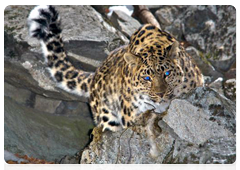MULTIMEDIA
 +
+
The Far Eastern leopard prefers areas of high relief, with steep hill slopes, rock outcrops and watersheds
 +
+
The Far Eastern leopard is the northernmost leopard subspecies, found north of the 45th parallel. These days, it can be found only in the southwest of the Primorye Territory
 +
+
Sergei Ivanov is the curator of the Far Eastern leopard preservation programme; he also chairs the board of trustees of the Eurasian Centre for the Study, Preservation and Rehabilitation of the Leopard Population, an independent non-profit organisation
 +
+
The maximum body length is 136 centimetres in males and 112 centimetres in females; the length of tails is 90 and 73 centimetres, respectively; the maximum weight is 60 kilogrammes
 +
+
Leopard newborns are blind, and have thick, long fur. Their skin is covered with small, solid brownish and black spots, with no rosettes. At birth, they weigh 500 to 700 grammes, on average, and measure 15 centimeters in length
 +
+
September 8, 2011, saw a long-awaited event – high-tech satellite collar was placed on a local leopard for future tracking
 +
+
Following the tagging, Vyacheslav Rozhnov spoke about some of the Far Eastern leopard surveying methods employed at the Institute of Ecology and Evolution he heads. He said the first results were likely to come in 2-2.5 years
 +
+
Sergei Ivanov offering watches to Wildlife Preserve personnel, along with encouragement for their conservation efforts. He then spoke with the preserve’s head, Sergei Khokhryakov, about projects aimed at promoting tourism, including through the creation of special tourist trails and proper infrastructure
 +
+
Far Eastern leopards become sexually mature by the age of 2.5 to 3, males usually a bit later than females
 +
+
In the past decade of the Far Eastern leopard surveying, the main attention has been paid to population monitoring using various approaches based on traditional methods such as track counts and camera traps
 +
+
Leopards are at their most active at night. They normally set out for their daily hunting an hour or two before sunset and spend the first half of the night on it. And it’s at dusk that they usually come out to drink
 +
+
The Far Eastern leopard programme has entered a new phase after two months of exploration across southwestern regions of the Primorye Territory, with existing camera traps checked and new ones installed
 +
+
This leopard, named Slavyanka, has been tagged with a Glonass/GPS/Argos satellite transmitter, allowing researchers to track the animal in real time using satellite maps
 +
+
According to the most optimistic estimates, the world’s Far Eastern leopard population is 40, with 30 leopards presumably dwelling in the Primprye Territory, and the remaining ten in China
 +
+
Unless emergency conservation measures are taken, the leopard population will go extinct. With this in mind, a strategy was enacted in Russia in 1999 to save the Far Eastern leopard
 +
+
Leopard Wildlife Preserve was set up in 2008. It incorporated two old preserves, Barsovy and Borisovskoye Plato, with the grounds totaling more than 169,000 hectares
 +
+
A young Himalayan bear got caught in a trap on September 6. Local scientists sedated her for a medical evaluation and then sent her back into the wild
 +
+
Leopard hunting was officially banned in 1956, but the expansion of agriculture, especially reindeer breeding, in leopard-populated areas destabilised the population
 +
+
Russia’s Nikolai Przhevalsky and Mikhail Yankovsky are the first researchers to have provided information about the Far Eastern leopard. They mentioned this species in their expedition notes
 +
+
China plans to set up nine frontier preserves for the Far Eastern leopard and the Amur tiger in the next few years
 +
+
Leopards’ life expectancy in the wild is 10 to 15 years, while in captivity they can live up to 20 years








 ABOUT THE PROGRAMME
ABOUT THE PROGRAMME
 FAR EASTERN LEOPARD RESEARCH: A HISTORY
FAR EASTERN LEOPARD RESEARCH: A HISTORY
 FAR EASTERN LEOPARD: LIFE, BEHAVIOUR AND MORE
FAR EASTERN LEOPARD: LIFE, BEHAVIOUR AND MORE
 SERGEY IVANOV'S VISIT
SERGEY IVANOV'S VISIT
 NEWS
NEWS
 MULTIMEDIA
MULTIMEDIA